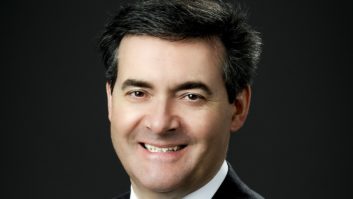Measuring the media
Apr 1, 2003 12:00 PM, By Scott Hanley
Ponder a daring new technology, years in the making that could dramatically change radio for the future. This technology is owned and championed by a single company, and will require new equipment for stations and for listeners, but there is no guarantee of success.
Sounds like HD Radio, right? Well, no. This futuristic tale is about the Portable People Meter (PPM), a new technology and system that may or may not revolutionize the way radio and other media uses are measured. The PPM is in the last stages of several years of field-testing, first in England and now in Philadelphia. The technology has been used in Singapore since 2001.
The PPM is a device about the size of a pager. The survey subject carries the device all day to detect what radio, TV and cable broadcasts are seen or heard.
At the end of every day, the PPM holder puts his meter into a base station cradle at home that will recharge the batteries and send the data from the collected codes to Arbitron to be tallied. The results can offer a minute-by-minute report of the media that was heard or seen for the entire day.
Each measured media outlet injects inaudible markers with a unique code into its audio stream. The PPM detects and records that code and tallies it by time of day. As an engineering project, it seems to work, but bringing the technology to market has been more complicated.
Relevance to stations
The latest generation of PPM encoder is a 1RU device that feeds an inaudible signal into a station’s audio path just before the audio processor. The level of the signal that carries the code has to be set properly, or there can be detection problems on the receiver end. This was evidenced during tests in Philadelphia.
From the left to right, the Arbitron PPM encoder, the PPM, the base recharger and the PPM collector, which collects the data from the PPM and sends it via modem to Arbitron.

The other side of the equation is the listener and his PPM. The survey subjects who receive the device would be selected for a broad demographic sample of a market. Unlike the once-a-week paper diary, participants would carry the PPM for as long as two years.
Once the survey participants have their PPM, it’s up to them to carry it with them wherever they go. They put it to rest at night only to recharge the battery and download the collected data to the cradle.
Preliminary audience measurements from the Philadelphia PPM tests showed similar shares and ratings with diary-derived estimates, but there were some differences, too:
- Cume audiences and reach were higher
- Morning drive listening was lower
- Time spent listening was lower
- The average number of stations used was higher
- More listening by young adults and men
- More listening on weekends, evenings and overnight
Rewards for using the PPM
As the PPM technology unfolds, managers and sales teams may face the biggest challenge of all: new terminology. In a real-time PPM world, the term average quarter hour (AQH) has little meaning. Audience measurement can now be observed to the minute.
Share becomes share of media, not just other radio stations. This combined media comparison to cable and broadcast television and even encoded online streaming media could be a benefit for radio.
Right now, Arbitron gives diary holders about a dollar for a completed diary; not much of an incentive for the effort. PPM participants will be given higher incentives and rewards to wear or carry the device every day, all day except overnight when the PPM is set in its cradle.
Because of the daily feedback loop, Arbitron plans to get greater compliance by survey subjects. Technical glitches should be easier to spot, too. And, because the PPM doesn’t require a diary entry, the potential to survey younger listeners becomes more possible. Our 12+ measurement for a cume audience would drop down to 6+.
The charger base can be placed in a convenient location.

Why Change to the PPM?
Companies that conduct research are having a harder time getting people to participate. Telephone call-out surveys have higher rates of refusal. Recruiting for focus groups and auditorium testing is getting more difficult and more expensive.
For Arbitron, response rates to paper diaries continue to decline; about 35 percent for radio nationwide and far less in some of the country’s largest radio markets. The few dollars handed out by Arbitron to diary keepers seems to be less and less an incentive to complete or return the paper diaries.
Improving the response rate and getting more precise and accurate data are of increasing importance in our more media-cluttered world. The drive to improve is strong enough that Arbitron and television’s Nielsen Media Research are working together closely to develop the PPM.
One concern expressed by the advertising community is that while programming is encoded, commercials are not. Advertisers want to know that their spots were heard. There are other concerns, too. How do you measure bath, shower and other private listening? How will it measure traveling listeners, who are often high-income people who spend days and weeks away from home and their base station? What about other people spending nights away from home? Will minority audiences be appropriately represented?
In addition, measuring headset radio listening requires an adapter to be plugged into a portable radio. How many people will comply? Yet, compared to the current system of paper diaries from Arbitron with a declining response rate, the PPM still looks to be a great improvement.
Arbitron says it will continue comparison tests in Philadelphia through the Winter 2003 ratings period. After that, more test panels are planned for 2003 and 2004. The 2002 plans anticipated reaching the top 100 DMAs and 170 radio metro markets by 2008. This timetable does not seem fixed, and it is affected in part by the status of a proposed joint venture with Nielsen.
Estimates of additional costs for stations and advertisers have not been made available. Implementing PPM technology will be expensive. It is a technological change that could dramatically alter the way media is measured. And because you become what you measure, imagine what changes could happen to radio in the process.
Hanley is director and general manager of WDUQ-FM, Pittsburgh.












